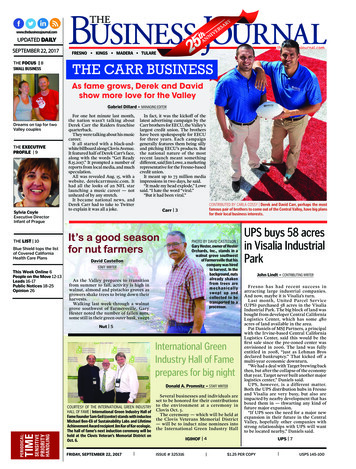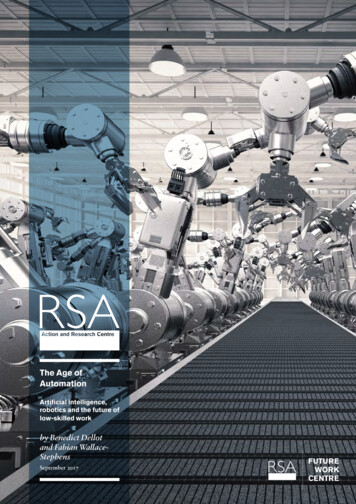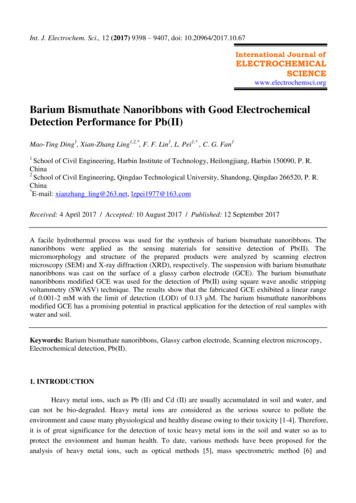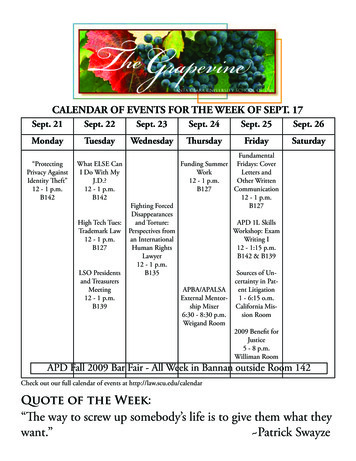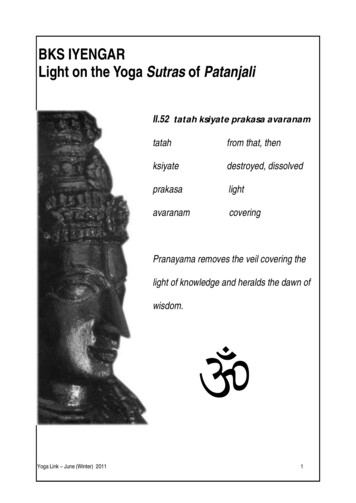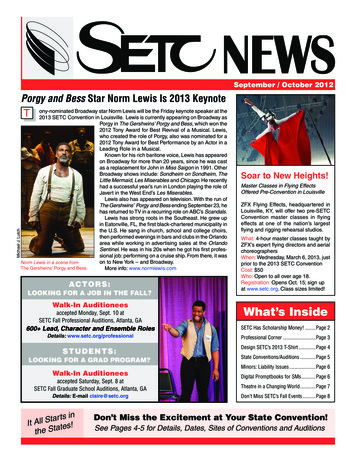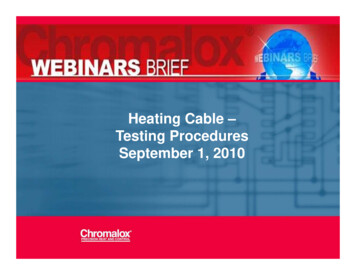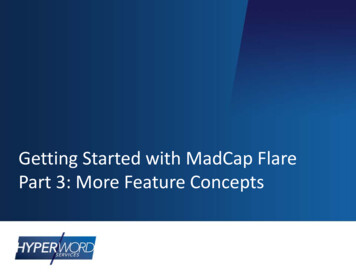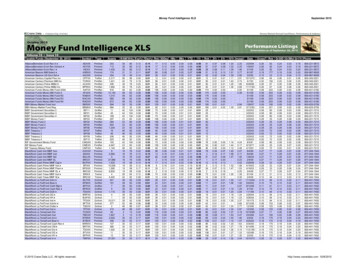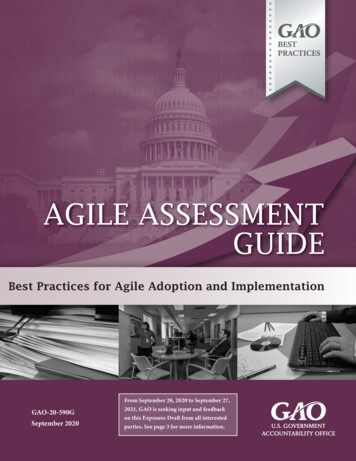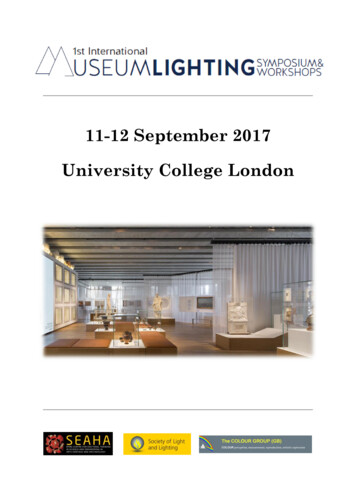
Transcription
11-12 September 2017University College London
11-12 September 2017, LondonOrganising Committee:Panos Andrikopoulos, PhD Researcher, SEAHA-CDT, UCLConference ChairDaniel Garside, PhD Researcher, UCLSecretary and TreasurerCarolien Coon, PhD Researcher, SEAHA-CDT, UCLVenue and LogisticsAnna Pokorska, PhD Researcher, SEAHA-CDT, UCLSubmissions SecretaryBrendan Keely, Secretary, SLLScientific Committee:Prof. Anya Hurlbert, ChairProfessor of Visual Neuroscience, Dean of Advancement, University of Newcastle;Scientific Trustee National GalleryJim DruzikSenior Conservation Scientist, Getty Conservation InstituteProf Ronier LuoProfessor of Colour and Imaging Science, Leeds University; Global ExpertiseProfessor, Zhejiang University Chair Professor, National Taiwan University ofScience and technology; Vice-President of CIEDr Sergio NascimentoAssociate Professor, University of MinhoJoseph PadfieldConservation Scientist, National Gallery, LondonBoris PretzelHead of Science, Conservation and Collections Management, V&ADavid SaundersVice President, International Institute for ConservationProf Andrew StockmanSteers Professor of Investigative Eye Research1 Page
11-12 September 2017, LondonCommercial Partners:2 Page
11-12 September 2017, LondonWelcome AddressMuseum lighting is like no other lighting field. Or any other vision, colour,conservation or material science field. Museum lighting involves manydisciplines and an even greater number of stakeholders; lighting designers,architects, exhibition designers, conservators, material, vision and lightingscientists, to name a few. All these practitioners approach the problem from withdifferent perspectives, interests, backgrounds and methods, and they eachemploy a subtly different professional language. This can causemiscommunication and isolation.Museum and gallery illumination is at a crossroad. The drive to reduce energyconsumption has led to a wide and rapid adoption of LED technology bymuseums and heritage institutions. LED technology creates new opportunitiesand poses new challenges to colour, lighting and conservation science andpractice. While LED technology allows for novel applications such asoptimisation of the spectrum for vision and/or preservation, it has revealedinadequacies in existing colour reproduction measures, has not yet proven to becost effective, and has raised concern over light induced damage. Projects likethe illumination of the Sistine Chapel, where the light source was specificallyoptimised to the pigments used for the murals, showcase the possibilities buthighlight the need for engineering the capabilities of LED technology.When we conceived the idea for a Museum Lighting event, we had all the abovein mind. We envisaged a symposium acting as a round table for all thedisciplines involved in the field, whether within industry or academia. Ashowcase where industry professionals would be able to discuss state of the artresearch in order to apply it in the real world, and where researchers would beable to learn more about the challenges of real-world application.From our programme, and the demographics of the audience, we are hopeful thatwe will accomplish the above aims. Our audience is diverse: 26% of the audienceare museum professionals, while 24% comes from academia. 23% are part of thelighting manufacturing industry, while 15% are lighting designers andspecifiers. I believe that this split, along with the fact that the event has beentwice sold out long before the actual date, demonstrates a great and growinginterest for the field from all the stakeholders.In organising the event we have not been alone. Firstly, we had the support ofour academic home: The Centre for Doctoral Training in Science andEngineering in Arts, Heritage and Archaeology (SEAHA-CDT). We also had thesupport of the Chartered Institution for Building Services Engineers, Society ofLight and Lighting. They supported and believed in the event from day one.3 Page
11-12 September 2017, LondonAnd this is where we normally acknowledge sponsors. Except we did not haveany. Instead of sponsors we had commercial partners. Whilst this might soundlike sophistry, it is not. When we first started looking for commercial partners,we had to introduce a new framework for collaboration in a conference,something we really believed in. That is, we asked commercial partners tocollaborate with us in providing workshops - sharing their knowledge andexpertise. As a result of this, our programme includes four workshops. WorkshopA: “Relighting the Petrie Museum: Smart Lighting and Proximity AwareServices in Museums”, organised in association with Xicato and Mike StoaneLighting and led by Boris Pretzel, is not only a demonstration of the capabilitiesof connected lighting in museum environments, but also an open discussion onthe potential of the technology. Workshop B, “Precision LED drivers for viewingand digital imaging” provided by eldoLED, is a demonstration of the implicationsand importance of dimming LEDs in museums. Workshop C:“Psychophysiological Methods for Lighting Research and Design” provided byZumtobel and led by Prof Anya Hurlbert, introduces new methods andtechniques to be employed for post- and pre-occupancy evaluation. Workshop D:“Modern Colour Science for Museum Lighting”, provided by Soraa and CocoLighting and led by Aurelien David, discusses all the latest advancements inmodern colour science.Museum lighting research usually happens in the lab, outside of its real context.Although this is not ideal, it is often a pragmatic decision. Depending on theapplication, the importance of lighting research in situ is widely acknowledged.For this event, we have collaborated with the UCL Museums and Collections, towhich we are deeply grateful, for providing an opportunity to be able to havesome of the workshops in real museum environments. This aligned well with theaim of UCL Museums and Collections to become a ‘museum research hub’. As alegacy of the Museum Lighting Symposium and Workshops a lighting system,which is optimisable up to the last spotlight and with the ability to track thelocation of visitors, has been installed in the Petrie Museum. This system is opento UCL and non-UCL researchers for lighting studies.We would also like to express our gratitude to the members of the scientificcommittee for the hours spent in reviewing the abstracts and drafting anexcellent programme. Their contribution was the most important and their trustin the event is something I hope we can live up to. We would also like to thankthe The Colour Group (GB) for their support in advertising the event which, as afirst-time event has been important.Finally, but most importantly, we would like to thank all the delegates forjoining this event from around the world, despite the time and cost implications.Our aim was to create a round table for the different disciplines and yourpresence at the event is key to its success.4 Page
11-12 September 2017, LondonXicato designs and manufactures intelligent lighting components that enabledesigners to create beautiful, smart spaces in which people love to live and work.Xicato is defining the future of intelligent light sources by integratingelectronics, software and connectivity.Xicato’s XIM Gen4 integrates Corrected Cold Phosphor Technology for thehighest quality, longest lasting light, a deep dimming driver, wired and wirelesscontrol, and Bluetooth beacons, all in a compact, efficient package. The XIMGen4 ecosystem includes switches, sensors, gateways and software that aredesigned for scalable commercial applications.For museums, smart lighting can offer savings via lower energy consumption,sensor triggering and predictive maintenance. Commissioning is simplified.Visitor experiences can be enhanced with proximity aware services. Upgrades tosmart lighting can be realized without disruption or gallery closure.Founded in 2007 is headquartered in Silicon Valley, Xicato has offices globally.For further information: www.xicato.comSoraa has pioneered the use of LEDs built from pure gallium nitride substrates(GaN on GaN ), making ordinary lighting extraordinarily brilliant andefficient. Soraa is the world leader in LED technology and the illuminator of theworld’s most renowned museums, historical buildings, hotels, and luxuryshops. Soraa products have also been installed at the San Francisco Museum ofModern Art, the J. Paul Getty Museum, and the Ashmolean Museum in Oxford.Soraa’s full spectrum GaN on GaN LED lamps have superior colour renderingand beam characteristics compared to LED sources created from non-nativesubstrates. Founded in 2008, Soraa is located in Fremont California, where itmanufactures its GaN on GaN LEDs in the company’s state-of-the-art facility.For additional information, please visit www.soraa.com and follow uson Twitter, Facebook, Instagram, and LinkedIn.5 Page
11-12 September 2017, LondonAs a leader in innovation, Zumtobel develops sustainable lighting solutionstailored to the needs of people in their respective applications. With acomprehensive portfolio of high-quality luminaires and intelligent lightingmanagement systems, the Austrian company provides optimum indoor andexterior products for working and living spaces – the right light for every activityat any time ofday. The applications office, education, presentation and retail, hotel andwellness, health, art and culture and industry are now perfectly complementedwith portfolios for living and outdoor areas. Zumtobel is a brand of ZumtobelGroup AG with its head office in Dornbirn, Vorarlberg (Austria). Zumtobel. TheLight.eldoLED is a world leader in the design and manufacture of intelligent drivesolutions for LED based lighting systems. eldoLEDs technologies empower theircustomers to deliver the promise of LED lighting: smarter, sleeker and moreefficient systems. More importantly, eldoLED focusses on ‘Quality of Light’. Thechoice of the driver is crucial to achieve healthy light: best smooth dimming allthe way down to 0.1% / dark combined with truly ‘flicker-free’ light, according toIEEE1789 regulation, which mitigates adverse effects caused byflicker. eldoLED is where lighting electronics meets the human body.Mike Stoane Lighting is a design led specialist manufacturer ofarchitectural lighting equipment based in Edinburgh, Scotland. The companywas founded in 1995 when Mike started making light fittings in his garage. Wehave grown considerably since then and are now an Employee Owned company.Our close relationship with lighting designers and architects has resulted insupply of our luminaires to prestigious projects worldwide; from iconic newbuildings to historic castles, palaces and places of worship. Built to order in6 Page
11-12 September 2017, LondonEdinburgh, all of our equipment is designed and tested to be suitable for thespecific demands of each project. We have established our reputation bymanufacturing solidly built, easy to use, aesthetically simple but technicallyadvanced luminaires, particularly for the museum and gallery sector. We arewell known for our flexibility and capability when it comes to the manufacture ofbespoke luminaires. The scale and complexity varies hugely, sometimesrequiring development of out-and-out specials but very often utilising equipmentfrom our extensive catalogue of standard hand built equipment.COCO Lighting is the largest distributor of SORAA products within the UK,working side-by-side with the LED specialists to deliver exceptional quality oflight products to its growing customer base. As the UK’s only SORAA GoldPartner distributor, COCO Lighting retains extensive stock levels to ensurequick project fulfillment.In addition, COCO Lighting is an ICEL 1004:2014 accredited EmergencyLighting and LED Conversion Specialist with over 30 years’ experience inluminaire conversion procedures. With a team of experienced engineers, COCOLighting can ‘re-engineer’ just about any light fitting to LED and/or emergency,saving up to 90% in energy costs.COCO Lighting takes pride in its “Rapid Response Policy” applying this to allprojects and administrative requirements, ensuring their customers receiveinformation and merchandise as quickly as possible. This procedure is endorsedby ensuring that their carefully selected teams are fully versed in all ISO 9001and ISO 14001 procedures, offering a high quality, reliable and efficient serviceat competitive prices.For more information visit: www.cocolighting.com or follow us on Twitter.7 Page
11-12 September 2017, LondonProgramme:DAY 19:00 Registration9:50 Opening AddressCase Studies10:00 Keynote: Lighting theNew Acropolis Museum10:50 Tea Break11:20 Museum Lighting Daylight Autonomy andApplication of NovelArtificial LightingTechnologies inMuseums11:45 Climate based daylightmodelling for lightmanagement in historichouse showrooms12:10 Illuminating Artwork different projectexamples in cooperationwith the VaticanMuseums12:35 LunchLight, colour and vision (Part I)13:35 In Praise of Spotlighting14:00 Evaluation of colourquality of LEDillumination for MuseumApplicationsAnyaHurlbert Chair, ScientificCommitteeFlorence Lam Global Head ofLighting, ARUPGroupAndreasSchulz CEO, Licht KunstLicht AG,Bonn/BerlinChair IALD EuropeSteering Committee Nigel Blades MouradBoulouednine ScottRosenfeldRonnier Luo 8 PagePreventiveConservation Adviser(Environment),National TrustRegional Head ofProjects Europe,OSRAMLighting Designer,Smithsonian InstituteVice-President ofInternationalCommittee forIllumination (CIE)Professor of Colourand Imaging Science,Leeds UniversityGlobal ExpertiseProfessor, ZhejiangUniversity ChairProfessor, NationalTaiwan University ofScience andtechnology.
11-12 September 2017, London14:25 Artificial Lighting Designfor Paintings in IndoorSettings with selectedNanyang Paintings as acase study.14:50 Light and colour:Assessing the effects ofillumination onperceptual constancy ofand aesthetic response topaintings15:15 Poster SessionLight, colour and vision (Part II)16:45 Colour preference andnaturalness of paintingsunder multi-LED spectrawith different correlatedcolour temperatures andobject saturation levels17:10 Influence of culturalfactors in preferredillumination forpaintings17:35 The Preferred Conditionsof LED Lighting for FineArt Paintings: TheInfluence of IlluminanceLevel and CorrelatedColour Temperature18:00 End of Day18:30 Drinks ReceptionDAY 2Light Damage9:00 Mitigating Light Damagein a New ExhibitionSpace at the GettyResearch Institute9:25 A microfading survey ofthe lightfastness of blue,black and red ballpointpen inks in ambient andmodified environmentsNicholas OngThian Chai MA Student,NanyangTechnologicalUniversityAnyaHurlbert Prof of VisualNeuroscience,Newcastle UniversityScientific Trustee,National Gallery,London9:50StefanMichalskiKeynote: Museumlighting - 30 years ofdevelopments andlessons for the future9 Page Peter Bodrogi Senior researchfellow, Laboratory ofLighting Technologyof the TU Darmstadtin DarmstadtSergioNascimento Associate Professor,University of MinhoFerenc Szabó Assistant Professor,University ofPannoniaMark Benson AssistantConservator, GettyResearch InstituteBruce Ford Researcher,National Museum ofAustraliaindependentconservation scienceconsultantSenior conservationscientist, CanadianConservationInstitute (CCI)
11-12 September 2017, London10:40 Tea BreakWorkshops11:10 Workshop AWorkshop B in Workshop C in Workshop D inin associationassociation with association with association withwith Xicato &eldoLEDZumtobelCoco Lighting &MSLSoraa12:10 Workshop AWorkshop B in Workshop C in Workshop D inin associationassociation with association with association withwith Xicato &eldoLEDZumtobelCoco Lighting &MSLSoraa13:10 LunchCollection Care and Policy14:10 Wavelength dependenceDavid Getty/Rothschildand relative damageSaundersFellowfactors: an overview Honorary researchfellow at the BritishMuseum Vice president of theInternationalInstitute forConservation14:35 Are we being too easilyEmma Lecturer in MaterialLED? Assessing theRichardsonStudies, UCLimpact of LED lightingon pigments and paper inheritage collections15:00 Implementing fullyKerri Director oftuneable spectrum LEDCallahanArchitectural Projectlight sources at the ArtManagement &Institute of Chicago:Planning at The Artperspectives fromInstitute of Chicagolighting design andconservation15:25 Object-Specific LightingRoss D. Doctoral researcherDesign for Mark Rothko's Uthoffin the AppliedGreen on Blue, aOptics Lab at theCollaboration betweenCollege of OpticalThe University ofSciences at theArizona Museum of ArtUniversity ofand College of OpticalArizonaSciences15:50 Tea break16:20 Fading colours and theKees van den Head of Collectionnecessity for a new high- Meirackerand Conservation,quality LED-museumVan Gogh Museumlighting system10 P a g e
11-12 September 2017, London16:55 Upgrading Standardsand Guidelines for themuseum lighting: how toinclude new researchresults within anoutdated model?17:20 Towards the newstandard for museumlighting in JapanCostanzaCucci NozomuYoshizawaand YokoMizokami 17:55 Closing RemarksPanosAndrikopoulos 18:00 End of Day11 P a g e Researcher,Institute of AppliedPhysics “NelloCarrara”, ItalianNational ResearchCouncil (IFAC-CNR)Professor, TokyoUniversity of ScienceAssociate Professorin Department ofImaging Sciences,Graduate School ofEngineering, ChibaUniversityChair, OrganisingCommittee
11-12 September 2017, LondonContentsKeynote Speakers . 16Lighting the New Acropolis Museum (Florence Lam) . 16Museum lighting - 30 years of developments and lessons for the future. (StefanMichalski). 18Presenters. 21Podium Presentations. 30Case Studies. 30Museum Lighting – Daylight Autonomy and Application of Novel Artificial LightingTechnologies in Museums (Prof. Dipl.-Ing. Andreas Schulz) . 30Climate based daylight modelling for light management in historic house showrooms(Nigel Blades, Katy Lithgow, John Mardaljevic, Stephen Cannon-Brookes and LisaMcCullough) . 32Illuminating Artwork - different project examples in cooperation with the VaticanMuseums (Dipl.-Phys. M. Boulouednine and Dipl.-Ing. Carlo Bogani) . 35Light, Colour and Vision (Part I) . 37In Praise of Spotlighting (Scott Rosenfeld) . 37Evaluation of colour quality of LED illumination for Museum Applications (MingRonnier Luo and Kangjun Liu) . 40Artificial Lighting Design for Paintings in Indoor Settings with selected NanyangPaintings as a case study (Ong Thian Chai Nicholas, Martin Reiser (†), Assoc. Prof.Cesare Soci, Dr. Sarita Silveira, Assoc. Prof. Andrea Nanetti) . 42Light and colour: Assessing the effects of illumination on perceptual constancy of andaesthetic response to paintings (Anya Hurlbert and Joseph Padfield) . 44Light, Colour and Vision (Part II) . 4512 P a g e
11-12 September 2017, LondonColour preference and naturalness of paintings under multi-LED spectra withdifferent correlated colour temperatures and object saturation levels (P. Bodrogi, T. Q.Khanh, Q. T. Vinh, X. Guo). 45Influence of cultural factors in preferred illumination for paintings (Sérgio NCNascimento, João M.M. Linhares, Catarina F. M. Herdeiro, Taisei Kondo, YukinoriMisaki, Shigeki Nakauchi) . 49The Preferred Conditions of LED Lighting for Fine Art Paintings: The Influence ofIlluminance Level and Correlated Colour Temperature (Ferenc Szabó, Renáta Kéri,Péter Csuti) . 50Light Damage . 53Mitigating Light Damage in a New Exhibition Space at the Getty Research Institute(Mark Benson) . 53A microfading survey of the lightfastness of blue, black and red ballpoint pen inks inambient and modified environments.(Bruce Ford) . 58Collection Care and Policy. 61Wavelength dependence and relative damage factors: an overview (David Saunders)61Are we being too easily LED? Assessing the impact of LED lighting on pigments andpaper in heritage collections (Emma Richardson, Elizabeth Woolley, Asya Yurchenko,Dave Thickett) . 63Implementing fully tuneable spectrum LED light sources at the Art Institute ofChicago: perspectives from lighting design and conservation (Kerri Callahan,Francesca Casadio, Sarah Casto, Sylvie Penichon, Antoinette Owen, Frank Zuccari) 66Object-Specific Lighting Design for Mark Rothko's Green on Blue, a Collaborationbetween The University of Arizona Museum of Art and College of Optical Sciences(Ross D. Uthoff, Nathan W. Saxton, Rachel N. Ulanch, Kaitlyn E. Williams, PageKing, Liliana Ruiz Diaz, R. John Koshel) . 69Fading colours and the necessity for a new high-quality LED-museum lighting systemwith a clear formulated light policy for the paintings by Vincent van Gogh (Kees vanden Meiracker). 7113 P a g e
11-12 September 2017, LondonUpgrading Standards and Guidelines for the museum lighting: how to include newresearch results within an outdated model? (Costanza Cucci and Marcello Picollo). 75Towards the new standard for museum lighting in Japan (Nozomu Yoshizawa, YokoMizokami, Chie Sano, Naoto Yoshida) . 77Posters . 79A status quo about the LED Lighting applications in the Chinese Museums andGalleries (Jing Ai) . 79Focus on Art by avoiding distracting color differences in the illumination - Revolutionof the LED white binning (Alexander Wilm and Carolin Horst) . 81Assessment of the photo-stability of plastics found in heritage collections to visiblelight (Anna Pokorska, Lindsay MacDonald, Elise Talgorn, Stuart Robson, KatherineCurran, Boris Pretzel) . 82Natural Light Matters: surveying illumination at the Museum of Modern Art(B. Campbell, H. Murata, J. Hickey, L.A. Daffner, E. Mosier, A. Martins) . 83Let LED Respect your ART Or How to Define State of the Art LED Systems for ArtGalleries - A Field Report. (Claude Hidber) . 84Evaluation of Colour Rendition Methods Through Museum Lighting Investigationsand Determination of Preferred Conditions for Fine Art Paintings (Péter Csuti, FerencSzabó, Renáta Kéri). 86Take deLIGHT in Colours (Francesca Feltrin, Kevin Smet, Peter Hanselaer, KavehAhmadian Tazehmahaleh) . 88LED lighting quality in museum showcases: results of an experimental case study(Gabriele Piccablotto, Anna Pellegrino, Chiara Aghemo) . 91The Interactions between Museum Lighting and Optically Coated Glazing (JenniferBooth) . 95Moths to the flame: An investigation of the influence of lighting on museum visitorbehaviour (Jessica Glaisher) . 9714 P a g e
11-12 September 2017, LondonLight and Art - LED and the new possibilities in object lighting (Kay-Uwe Dingeldein,Dario Maccheroni, Ralf Maller) . 100Lighting in museums, visitors' experience and satisfaction in a heritage context. Studycases in Northwest Argentina (L.N. Bazán, R.F. Ajmat, J.D. Sandoval) . 103The role of light on visitors' experience of the Parthenon Marbles in the AcropolisMuseum (Panos Andrikopoulos, Kalliopi Fouseki, Panos Mavros, Andy Hudson-Smith,Frangiskos Topalis). 110Replicating Blue Wool Testing for Art Conservation Using a SmartphoneSpectrometer (Rachel N. Ulanch and R. John Koshel) . 114Lighting preference of artworks under multiple correlated colour temperaturescondition (Qiang Liu, Rui Peng, QingMing Li, Yang Tang, MeiHua Tang, KaiDa Xiao,Ming Ronnier Luo) . 117Preference of Paintings under LED Lightings with Variations of CCT, Colour Fidelityand Colour Gamut (Qiyan Zhai, Ming Ronnier Luo, Ching-Ju Chou, Hung-ShingChen) . 119Senses and thoughts: The light in the Kunsthaus Bregenz designed by Peter Zumthor(Seda Kaçel and Benson Lau) . 123Influence of LED lighting on the stability of modern paint materials (ValentinaPintus, Ferenc Szabo, Peter Csuti, Federica Cappa, Carlotta Salvadori, Renata Kari,David Noel That, Rita Wiesinger, Marta Anghelone, Zafia Nyari). 126Lighting beyond art: choreographing views and appearances for the perceptive body(Veronika Mayerboeck, Elke Oberthaler, Sabine Penot, Alison Ritter) . 128Workshops . .130Workshop A: Relighting the Petrie Museum: Smart Lighting and Proximity AwareServices in Museums 131Workshop B: Precision LED drivers for viewing and digital imaging .132Workshop C: Neuropsychological methods for lighting design and research 133Workshop D: Modern Colour Science for Museum Lighting 13415 P a g e
11-12 September 2017, LondonKeynote SpeakersLighting the New Acropolis MuseumFlorence LamBA(Cantab.) MA(Cantab.) MSc CEng FIET FCIBSE FSLL Fellow,Global Lighting Design Leader, ArupFlorence is Fellow and Director at the international design,engineering and business consulting firm, Arup. She leadsArup’s global lighting design practice. Her particularexpertise include daylight, visual perception and holisticlighting approach, which play a key role when illuminatingmuseums all over the world. Museum projects of significanceinclude the New Acropolis Museum in Athens, Rijksmuseumin Amsterdam, Museo Picasso in Malaga, CaliforniaAcademy of Sciences in San Francisco, Nasher SculptureCenter in Dallas, Royal Ontario Museum in Toronto, BritishMuseum World Conservation Centre and Tate Modern in London, the Hepworth in Wakefield andthe V&A Museum of Design in Dundee. She has co-authored in the publication of the RIBATechnical Review series on Lighting and a book called Space Craft on Developments in theArchitectural Computing. Florence was named the Lighting Designer of the Year at the UKLighting Design Awards in 2013. She is also the recipient of the Lighting Award from the Societyof Light and Lighting in 2014. At the Museum Lighting Symposium, Florence will be discussinglighting in the New Acropolis Museum.ABSTRACTThe New Acropolis Museum is amongst the most important public projects in Greece of the 21stcentury. 1,000ft southeast of the Parthenon, the New Acropolis Museum stands on more than 100concrete pillars suspended over an excavation site. Glass filled holes in the floor reveal ancientruins and the glass walls of the Parthenon Gallery provide visitors with a panoramic view of theAcropolis and modern Athens. The sky-lit space is rotated to sit in alignment with the Parthenon.At its centre, a rectangular concrete core hosts a Parthenon frieze, placed in the exact sameorientation as when it adorned the monument. Nearly 4,000 objects most coming from Acropolisare exhibited over an area of 14,000 sqm. The museum opened to the public in June 2009 an
Zumtobel and led by Prof Anya Hurlbert, introduces new methods and techniques to be employed for post- and pre-occupancy evaluation. Workshop D: “Modern Colour Science for Museum Lighting”, provided by Soraa and Coco Lighting and led by Aurelien David, discus

